
Sammy Marks
Encyclopedia



Life history
Born the son of a Jewish tailor in 1843/44 at Neustadt-Sugind (Žemaičių NaumiestisŽemaičių Naumiestis
Žemaičių Naumiestis is a small town in Klaipėda County, in western Lithuania. According to the 2001 census, the town has a population of 1,716 people....
), in Lithuania
Lithuania
Lithuania , officially the Republic of Lithuania is a country in Northern Europe, the biggest of the three Baltic states. It is situated along the southeastern shore of the Baltic Sea, whereby to the west lie Sweden and Denmark...
, Russia and endowed with integrity, courage, astonishing business acumen and immense vitality. Marks accompanied some horses to Sheffield
Sheffield
Sheffield is a city and metropolitan borough of South Yorkshire, England. Its name derives from the River Sheaf, which runs through the city. Historically a part of the West Riding of Yorkshire, and with some of its southern suburbs annexed from Derbyshire, the city has grown from its largely...
in England while still a youth and not wanting to return to the Jewish persecution in Russia, decided to stay on. It was in Sheffield that he met his future in-laws. Hearing news of the diamond discoveries in Kimberley
Kimberley, Northern Cape
Kimberley is a city in South Africa, and the capital of the Northern Cape. It is located near the confluence of the Vaal and Orange Rivers. The town has considerable historical significance due its diamond mining past and siege during the Second Boer War...
, he arrived at the Cape in 1869 and was shortly followed by his cousin Isaac Lewis, also from Neustadt-Sugind, with whom he forged the enduring partnership of Lewis & Marks. Marks started his career as a peddler in the rural districts of the Cape, but soon headed for Kimberley where his rise to prosperity began. They made a modest living supplying goods to mines and diggers, and later branched into diamond trading. Moving to Pretoria
Pretoria
Pretoria is a city located in the northern part of Gauteng Province, South Africa. It is one of the country's three capital cities, serving as the executive and de facto national capital; the others are Cape Town, the legislative capital, and Bloemfontein, the judicial capital.Pretoria is...
in 1881 he gained the confidence of President Kruger and the government of the Zuid-Afrikaansche Republiek (ZAR). His friendship with Kruger became close and enduring and they had in common humble origins and a ready wit. Marks advised that Kruger build a railway line from Pretoria to Lourenço Marques
Maputo
Maputo, also known as Lourenço Marques, is the capital and largest city of Mozambique. It is known as the City of Acacias in reference to acacia trees commonly found along its avenues and the Pearl of the Indian Ocean. It was famous for the inscription "This is Portugal" on the walkway of its...
.
With the discovery of gold in the boomtown of Barberton
Barberton, Mpumalanga
Barberton is a town in the Mpumalanga province of South Africa, which has its origin in the 1880s gold rush in the region. It is situated in the De Kaap Valley and is fringed by the Mkhonjwa Mountains...
and later on the Witwatersrand
Witwatersrand
The Witwatersrand is a low, sedimentary range of hills, at an elevation of 1700–1800 metres above sea-level, which runs in an east-west direction through Gauteng in South Africa. The word in Afrikaans means "the ridge of white waters". Geologically it is complex, but the principal formations...
, Marks acquired business interests in both places, but found the coalfields of the southern Transvaal
South African Republic
The South African Republic , often informally known as the Transvaal Republic, was an independent Boer-ruled country in Southern Africa during the second half of the 19th century. Not to be confused with the present-day Republic of South Africa, it occupied the area later known as the South African...
and northern Free State
Free State
The Free State is a province of South Africa. Its capital is Bloemfontein, which is also South Africa's judicial capital. Its historical origins lie in the Orange Free State Boer republic and later Orange Free State Province. The current borders of the province date from 1994 when the Bantustans...
to be a more lucrative prospect. The Zuid-Afrikaansche en Oranje Vrijstaatsche Mineralen en Mijnbouwvereeniging was founded in 1892 to mine these coal deposits, and later gave the town of Vereeniging its name. Lewis & Marks business interests included a distillery, a canning factory and a glass factory. Their firm opened collieries at Viljoensdrif and elsewhere, and also started Vereeniging Estates Ltd., which was dedicated to developing agricultural land along the Vaal River
Vaal River
The Vaal River is the largest tributary of the Orange River in South Africa. The river has its source in the Drakensberg mountains in Mpumalanga, east of Johannesburg and about 30 km north of Ermelo and only about 240 km from the Indian Ocean. It then flows westwards to its conjunction...
. Marks pioneered the use of steam tractors and progressive farming implements. He also sponsored the establishing of flour-mills and brick and tile works at Vereeniging. In 1910 Marks was nominated as senator in the first Union Parliament, an office he held until his death. When A.H. Nellmapius
Alois Hugo Nellmapius
Alois Hugo Nellmapius 5 May 1847 - 27 July 1893, was a South African businessman, industrialist and pioneer conservationist.-Life and career:...
was unable to execute a manufacturing contract he had concluded with the Government due to lack of funds, Lewis & Marks took over and constructed the Eerste Fabrieken near Pretoria.
Marks contributed generously to Jewish communities all over South Africa. The Pretoria synagogue was built in 1898, for which he donated all the bricks and paid for the electric light installation and chandeliers. At the end of the Anglo-Boer War, he presented a cast-iron fountain to the city of Pretoria, shipped from Glasgow and very Edwardian in design, it stands at the Zoological Gardens. Marks commissioned the statue of Kruger on Church Square in Pretoria - sculpted by Anton van Wouw
Anton Van Wouw
Anton van Wouw was a Dutch-born sculptor regarded as the father of South African sculpture.-Biography:...
and cast in bronze in Europe, it carried a price tag of ₤10 000.
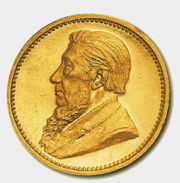
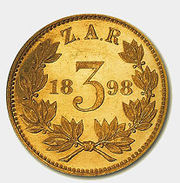
Sammy Marks tickey
In 1898 Marks was allowed the extraordinary privilege of using the state mint for a day. He was awarded the Jewish Cross for his services to his race. Marks used the opportunity to strike 215 gold tickeys – three-penny pieces that were normally silver – as mementos for his relatives and friends, including President Kruger and members of the VolksraadVolksraad
The Volksraad was the parliament of the former South African Republic , which existed from 1857 to 1902 in part of what is now the South Africa. The body ceased to exist after the British victory in the Second Anglo-Boer War. The Volksraad sat in session in Ou Raadsaal in Church Square, Pretoria...
. The gold would certainly have come from the Sheba mine near Barberton, the only gold mine in which Marks had a substantial stake. This famous incident says much about the close relationship that these two men had. There was often a blurring of the boundary between personal and State property. Their relationship was almost feudal, as that of a king and highly regarded
subject. Besides President Kruger, Marks enjoyed the trust of the Boer Generals Botha
Louis Botha
Louis Botha was an Afrikaner and first Prime Minister of the Union of South Africa—the forerunner of the modern South African state...
, De Wet
Christiaan De Wet
Christiaan Rudolf de Wet was a Boer general, rebel leader and politician.He was born on the Leeuwkop farm, in the district of Smithfield in the Boer Republic of the Orange Free State...
, and de la Rey
Koos de la Rey
General Jacobus Herculaas de la Rey , known as Koos de la Rey, was a Boer general during the Second Boer War and is widely regarded as being one of the strongest military leaders during that conflict....
, and the respect of Earl Roberts
Earl Roberts
Earl Roberts, of Kandahar in Afghanistan and Pretoria in the Transvaal Colony and of the City of Waterford, was a title in the Peerage of the United Kingdom. It was created in 1901 for Field Marshal Frederick Roberts, 1st Baron Roberts...
, Lord Kitchener
Herbert Kitchener, 1st Earl Kitchener
Field Marshal Horatio Herbert Kitchener, 1st Earl Kitchener KG, KP, GCB, OM, GCSI, GCMG, GCIE, ADC, PC , was an Irish-born British Field Marshal and proconsul who won fame for his imperial campaigns and later played a central role in the early part of the First World War, although he died halfway...
, and Lord Milner, and he played a not inconsiderable part in the negotiations for the cessation of Anglo-Boer hostilities at Vereeniging on 29 May 1902.
For many years Marks had planned an iron and steel works in the Transvaal, and had visited Britain to inspect the installations there at first hand. When he landed a contract with the Government in 1911 for smelting large quantities of scrap metal, he founded in 1912 the Union Steel Corporation.
Sammy Marks died in Johannesburg on 18 February 1920.
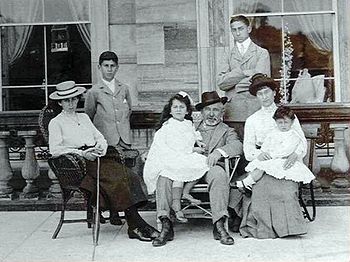
Family life
At forty years of age and a very wealthy man, Marks started thinking about marriage. He returned to Sheffield in England and married Bertha Guttmann, nineteen years his junior. From this union nine children were born, six boys and three girls. Having himself received a limited schooling, Marks set great store by education and saw to it that the children were taught at home by governesses - boys until the age of eight, girls until the age of twelve and then they were sent to private schools in England.
After Marks’ death, his widow and some of the children lived in the house until the death of the last one in 1991. After a period of standing vacant, the family realized it was in need of maintenance and a suitable tenant was sought. In 1984 an agreement was reached with the National Cultural History Museum according to which the Government was to buy the contents of the house from the estate, restore the house and rent it from the family trust. In 1986 the Sammy Marks Museum opened its doors to the public. In 1995 roughly 73ha surrounding the house and upon which all of the historical buildings are situated, was cut from the rest of the farm and sold to the National Cultural History Museum.
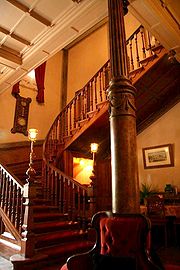
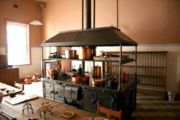
Sources
- Sammy Marks Museum
- SA History
- SA National Archives
- SA Coin
- Sammy Marks
- Sammy Marks: The Uncrowned King of the Transvaal ISBN 0-8214-0998-0
- Standard Encyclopaedia of Southern Africa vol.7 (Nasou, Cape Town 1972) ISBN 0 625 00323 3
- Sammy Marks: A new picture taken from the Lewis family album

